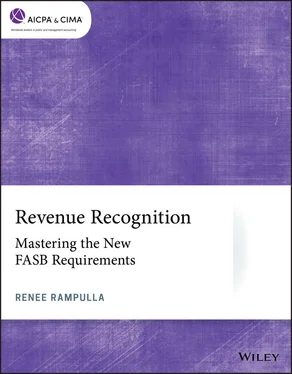Identify the performance obligations in the contract.
Determine the transaction price.
Allocate the transaction price to the performance obligations in the contract.
Recognize revenue when (or as) the entity satisfies a performance obligation.
In addition to these five-steps for recognizing revenue, ASU No. 2014-09 also addresses the following select areas:
Accounting for incremental costs of obtaining a contract, as well as costs incurred to fulfill a contract
Licenses
Warranties
 Key point
Key point
FASB ASC 606 has the potential to affect every entity’s day-to-day accounting and, possibly, the way business is executed through contracts with customers. Therefore, entities need to consider all aspects of their contracts with customers and not just the recording of a transaction into the general ledger.
1 In order to achieve its core principles, how many steps are described in FASB ASU No. 2014-09?Two.Three.Four.Five.
2 FASB ASC 606 provides a principle-based framework by introducing core principles that an entity should apply in order to recognize revenue. Which item is not being within the scope of FASB ASC 606?Software and technology.Motion pictures, music, and other forms of media and entertainment.Franchises.Insurance contracts.
The original effective dates of FASB ASU No. 2014-09 was revised by the issuance of the following ASUs:
FASB ASU No. 2015-14
FASB ASU No. 2017-13
As a result of these ASUs, the revised effective dates for FASB ASC 606 are as follows:
For public entities, ASU No. 2014-09 is effective for annual reporting periods beginning after December 15, 2017 (meaning January 1, 2018, for calendar year-end entities), including interim periods within that reporting period. Early application was permitted only as of annual reporting periods beginning after December 15, 2016, including interim reporting periods within that reporting period.
For nonpublic entities, ASU No. 2014-09 is effective for annual reporting periods beginning after December 15, 2018, and interim periods within annual periods beginning after December 15, 2019. Nonpublic entities may elect to adopt ASU No. 2014-09 earlier, only as of either of the following:An annual reporting period beginning after December 15, 2016, including interim periods within that reporting periodAn annual reporting period beginning after December 15, 2016, and interim reporting periods within annual periods beginning one year after the annual reporting period in which an entity first applied ASU No. 2014-09
For certain public business entities, ASU No. 2017-13 explains that the SEC staff has stated that they would not object to a public business entity using the non-public entity’s effectives providing the public business entity would not otherwise meet the definition of a public business entity except for a requirement to include or the inclusion of its financial statements or financial information in another entity’s filing with the SEC.
 Key point
Key point
The new revenue recognition standard describes a variety of effective dates. When considering the effective date exception in FASB ASU No. 2017-13, sometimes identifying whether an entity is within the definition of a public entity may not be very clear. See below for additional information from the FASB ASC master glossary:
“A public business entity is a business entity meeting any one of the criteria below. Neither a not-for-profit entity nor an employee benefit plan is a business entity.
It is required by the U.S. Securities and Exchange Commission (SEC) to file or furnish financial statements, or does file or furnish financial statements (including voluntary filers), with the SEC (including other entities whose financial statements or financial information are required to be or are included in a filing).
It is required by the Securities Exchange Act of 1934 (the Act), as amended, or rules or regulations promulgated under the Act, to file or furnish financial statements with a regulatory agency other than the SEC.
It is required to file or furnish financial statements with a foreign or domestic regulatory agency in preparation for the sale of or for purposes of issuing securities that are not subject to contractual restrictions on transfer.
It has issued, or is a conduit bond obligor for, securities that are traded, listed, or quoted on an exchange or an over-the-counter market.
It has one or more securities that are not subject to contractual restrictions on transfer, and it is required by law, contract, or regulation to prepare U.S. GAAP financial statements (including notes) and make them publicly available on a periodic basis (for example, interim or annual periods). An entity must meet both of these conditions to meet this criterion.
An entity may meet the definition of a public business entity solely because its financial statements or financial information is included in another entity’s filing with the SEC. In that case, the entity is only a public business entity for purposes of financial statements that are filed or furnished with the SEC.”
Chapter 2 Identifying The Contract With a Customer
Learning objectives
Distinguish the difference between a gain and revenue.
Identify the criteria needed in order to determine that collectability is probable within the context of FASB ASC 606.
Identify when an entity will need to continue to reassess whether a contract with a customer exists.
The core principle of the revenue recognition standard is that an entity should recognize revenue to depict the transfer of goods or services to customers in an amount that reflects the consideration to which the entity expects to be entitled in exchange for those goods or services. In order to achieve this core principle, an entity should be able to perform the following:
Step 1: Identify the contract with a customer
Step 2: Identify the performance obligations in the contract
Step 3: Determine the transaction price
Step 4: Allocate the transaction price
Step 5: Recognize revenue when or as the entity satisfies a performance obligation
 Key point
Key point
One key concept to remember is that the five steps are achieved consecutively; meaning if an entity cannot achieve the criteria in step 1 they cannot simply move on to step 2 and so on.
Key definitions used in this chapter
Before delving into the application of step 1, it is important to understand the following definitions in the FASB Accounting Standards Codification ®(ASC) master glossary:
Contract: An agreement between two or more parties that creates enforceable rights and obligations.
Customer: A party that has contracted with an entity to obtain goods or services that are an output of the entity’s ordinary activities in exchange for consideration.
Revenue: Inflows or other enhancements of assets of an entity or settlements of its liabilities (or a combination of both) from deriving or producing goods, rendering services, or other activities that constitute the entity’s ongoing major or central operation.
A gain is defined in FASB Concept Statement No. 6, Elements of Financial Statement, as :
Читать дальше

 Key point
Key point










